サステナブル和食とは。。? おせち料理作りを体験する研修員 What is Sustainable Washoku..? Participants experienced Osechi―new year japanese cooking.
2024.02.06
1月21日、研修員福利厚生プログラムでは日本文化体験として、サステナブル和食クラスを開催しました。

今回は日本料理の調理法が集約された年中行事であるおせち料理を、様々な宗派・嗜好の研修員向けにビーガン(完全菜食)で紹介しました。参加したのはブータン、トーゴ、カンボジア、インドネシア、タイ、メキシコから自国の課題解決の研究のために来日している研修員。
自己紹介をしてもらってクラスに申しこんだ理由を訊くと、「料理にそれぞれ意味があると聞いて学びたかった」「健康的な日本食を学びたい」「自分はビーガンだけどビーガンの和食は食べたことがないので」など、和食への興味を語ってくれました。
最初に和食で使う食材や、家族の幸福や繁栄を願うそれぞれの料理の意味、効能、作り方などを説明すると、感心したり、熱心にメモを取る研修員。こんにゃく、ゆり根、かんぴょう、日本発祥のセイタン(味付けした小麦たんぱく)、葛粉など、初めての食材も。
実習では皆で煮しめに入れる昆布巻きや、野菜の飾り切り、手綱こんにゃくをつくります。


今回はサステナビリティもテーマの一つ。
食は環境問題と密接にかかわっていますが、持続可能な地球のためには、温室効果ガス排出の大きな原因の動物性食品を減らしたり、できるだけ化学物質を使わず栽培された食材を使うのはもちろん、食材の無駄を減らすことも大切。普段捨ててしまう皮や糠の部分には、大切なミネラルや繊維、酵素等が含まれています。
ここでは野菜は皮を剥かずに使い、飾り切りで出た端切れも捨てずに刻んで松風焼きに入れました。人参のヘタもバサッと落とさず、土のついた部分だけ薄く削って使うよ、と見せるとOh~~とどよめく研修員。
人参を梅の型で抜き、簡単な切り目を入れると立体感が出るのを見て信じられない..! と感動していました。
今回のきんとんには栗の代わりにりんごを入れましたが、(有機では無いので)りんごの皮を剥いてもらうと、私たちは内に向かって剥くのに、外側に向かってシューーッと器用に剥く研修員がいて、その剥きぶりに一同大笑い。
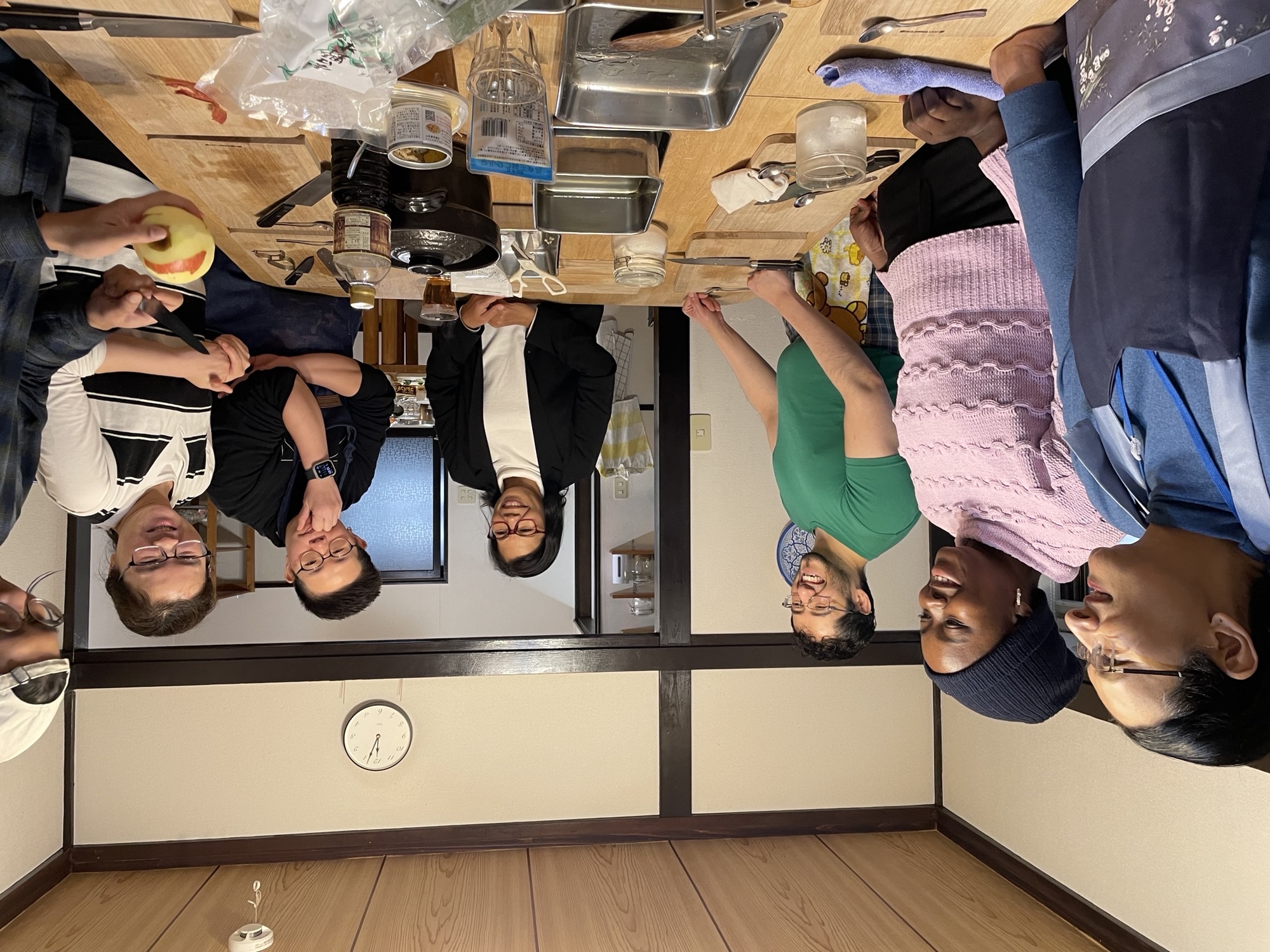
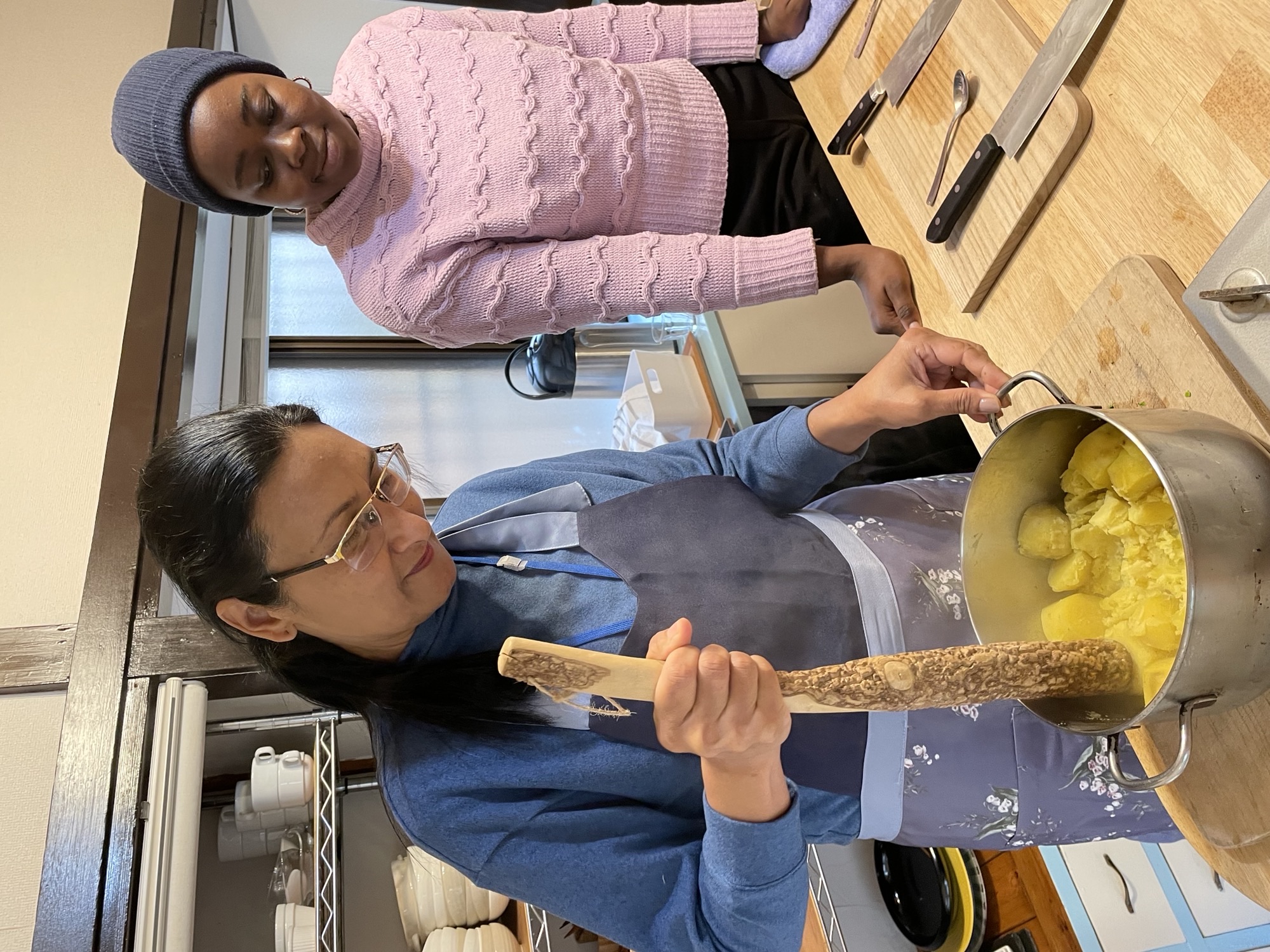
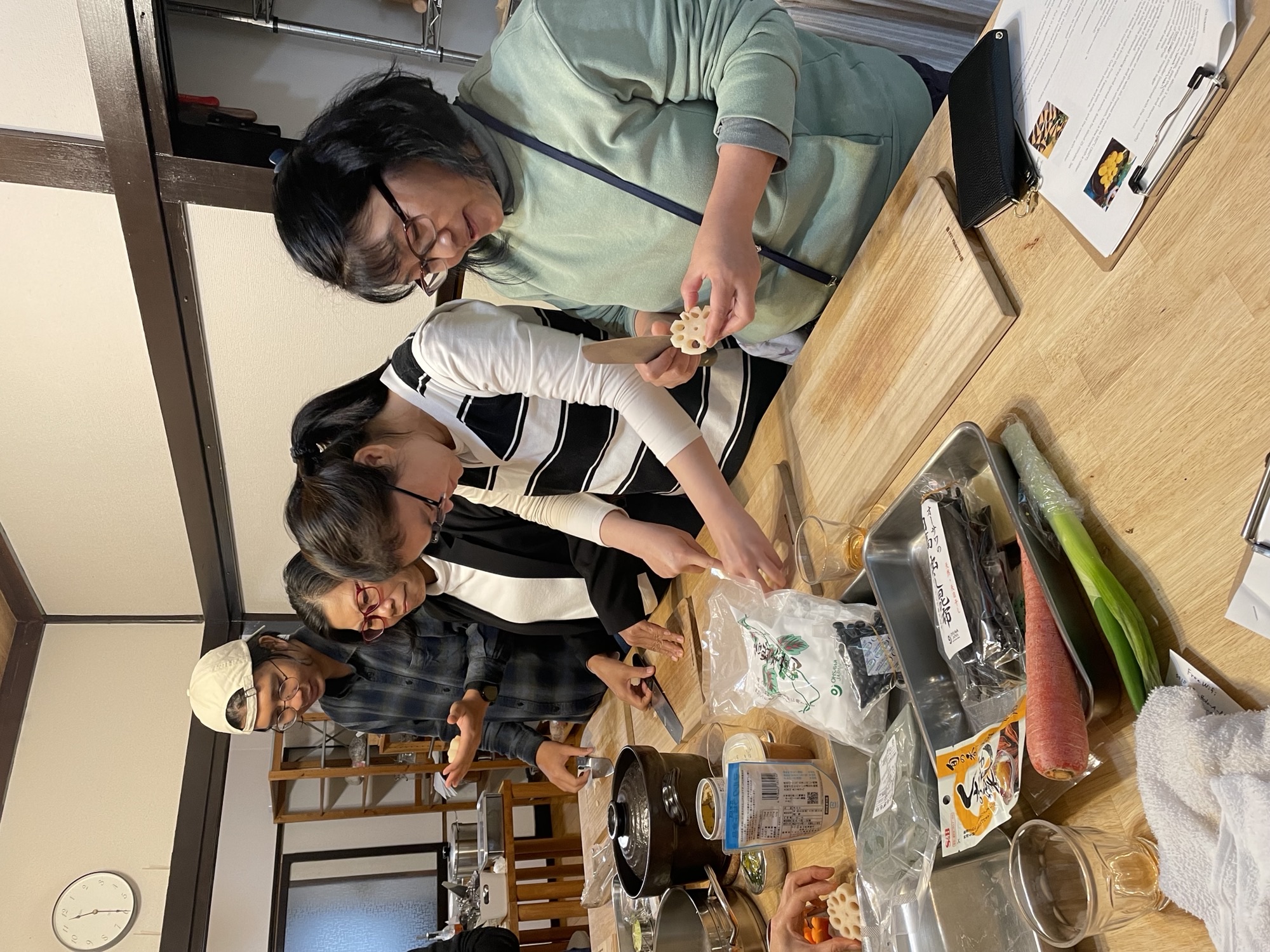
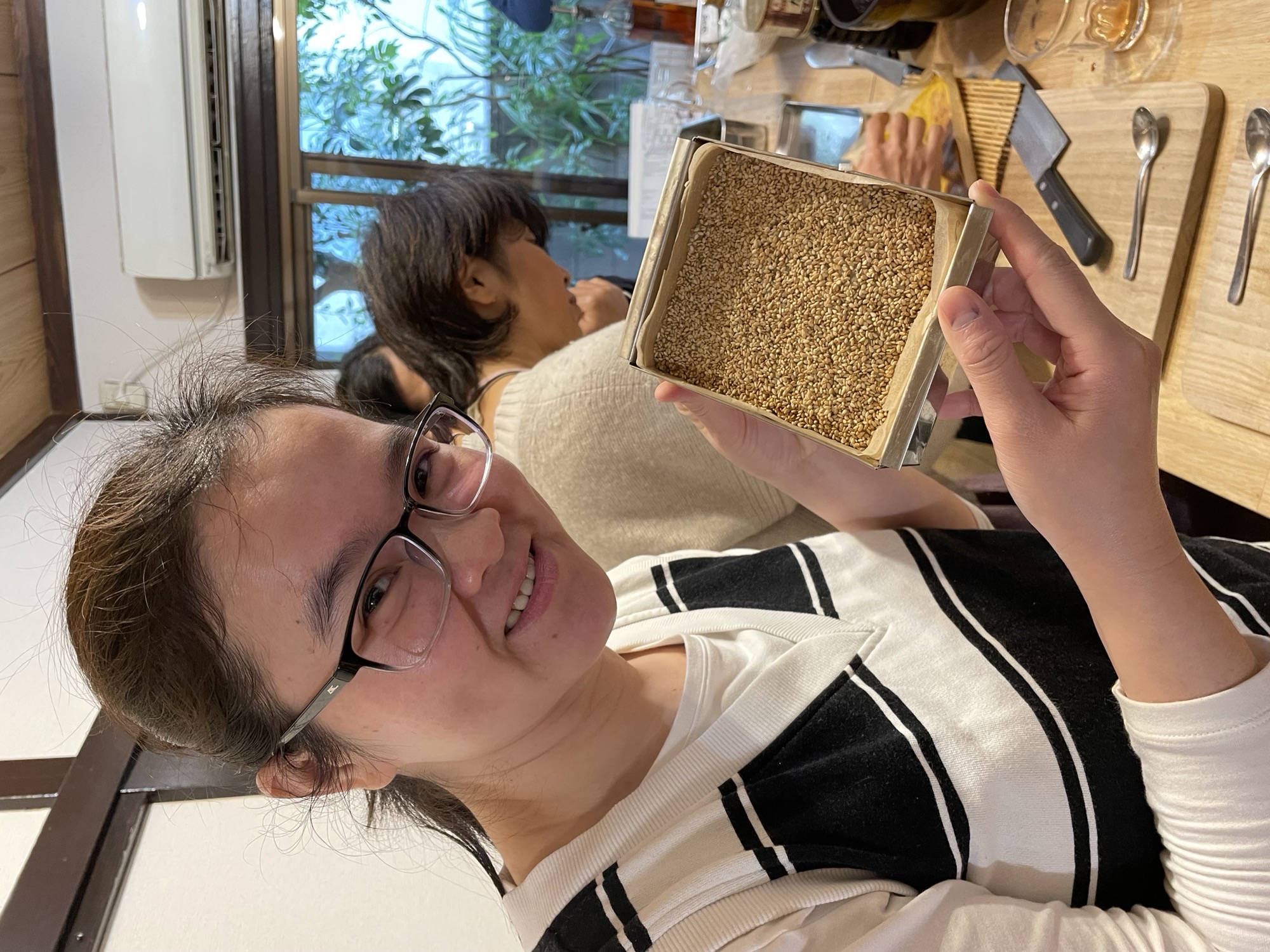
伊達巻、煮しめ、松風焼き、きんとん、なます、お雑煮とチームワークで次々に仕上げ、盛り付けは各自、好きなお皿を選んできれいに盛り付けて、「いただきます!」
試食では初めての料理や食材を、とても注意深く味わって食べる研修員。
人気はりんごの食感が楽しいきんとん、お肉無しの松風焼き、ごぼうで作ったサクサクの田作り。昆布と干椎茸で驚くほど旨味が出たお煮しめやお雑煮もとても美味しいと好評でした。
「自分の国の料理は、味付けが強くて素材の味をオーバーしている。和食では、人参なら人参の素材の味がよくわかる」と言っていた方も。
和食の良さ、おせちの楽しさを体験してもらえてとても嬉しかったです。
何より皆で料理を一緒につくるのは本当に楽しい時間でした。
参加してくれた皆さん、ご協力頂いた皆さま、ありがとうございました!



研修員のコメント
・素晴らしい機会をありがとう。私たちが作った料理の数々を、必ず作ろうと思います。このような機会に恵まれたことをとても幸せに感じています。
・持続可能な料理教室を企画してくれてありがとう。私が学んだ興味深いことのひとつは、無駄を出さない料理の仕方です。
・それぞれの食材の栄養的な利点や調理法を学ぶことができるこのイベントが好きです。友人やインストラクターと一緒に料理をするのは楽しくて、美味しい料理を楽しみました。おせち料理で新年を迎えたいと思いました。
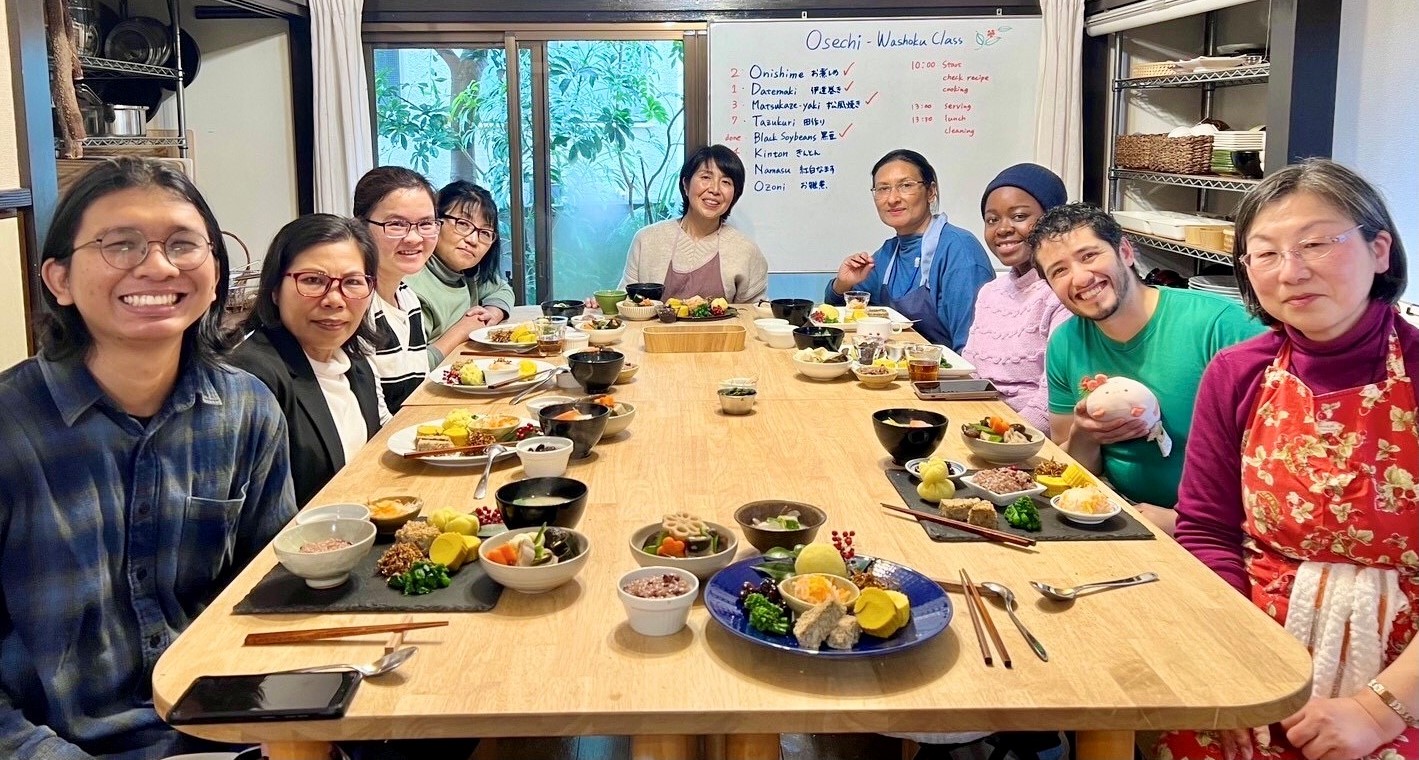

On January 21st, we held a Sustainable Japanese cooking class as a Japanese cultural experience in the Participants Welfare Program.
The participants from Bhutan, Togo, Cambodia, Indonesia, Mexico and Thailand who had come to Japan to research solutions to issues in their countries joined this event.
This time, we introduced Osechi ryori, an annual event that combines Japanese cooking methods, on a vegan basis to participants of various religious sects and tastes.
When asked why they signed up for the class after self-introductions, they expressed their interest in Japanese food: "I heard that each dish has its own meaning and I wanted to learn about it," "I wanted to learn about healthy Japanese food," and "I am a vegan but I have never had vegan Japanese food.”
When we first explained the meaning of each dish for the happiness and prosperity of the family, benefits and preparation of each ingredient and dish, the participants were impressed and eagerly took notes. Some of the ingredients were new to them, such as Konnyaku, lily root, Kanpyo, Seitan (cooked and seasoned wheat protein―which originated in Japan), and Kuzu flour.
During the hands-on cooking, everyone made Kobu-maki (kelp rolls) for Nishime, cut vegetables into decorative pieces, and Konnyaku tied to a reins.
Sustainability was one of the themes of this event.
Food is closely related to environmental issues, and for a sustainable planet, it is important to reduce animal foods, which are a major cause of greenhouse gas emissions, to use ingredients grown without chemicals as much as possible. And of course, it is also important to reduce food waste. Peels of vegetables and bran, which are usually discarded, contain important minerals, fiber, enzymes, etc.
Here, we used vegetables without peeling, and didn't throw away the scraps from the decorative cutting, we chopped and added to Matsukaze-yaki.
When I showed them that they don't have to remove the tops of carrots, just shave off the parts that have soil on them, they let out “Wow~”.
It was amazing for them to see how cutting out the carrots with a plum mold and making simple slits gives them a three-dimensional effect! “I can’t believe it..!!”
We put apples instead of chestnuts in the kinton this time, and when I asked the participants to peel them (since they’re not organic), one of them dexterously peeled it outward while we’re peeling it inwards, which made us all laugh.
We finished up Datemaki, Nishime, Matsukaze-yaki, Kinton, Namasu, and Ozoni one after another with nice teamwork, and each chose a plate of their choice for serving, arranged it neatly, and "Itadakimasu!"
The participants carefully tasted dishes and foods that are new to them.
The most popular dishes were kinton with a delightful apple texture, meat-free Matsukaze-yaki, and crispy Tazukuri made with burdock root. The Onishime and Ozoni, which are made with kombu and dried shiitake mushrooms broth and have an amazing “Umami” flavor, were also very tasty and well received.
One of them said, "In my country's cooking, the seasoning is so strong that it overpowers the taste of the ingredients. In Japanese cooking, if you eat carrots, you can really taste the carrots―taste of ingredients.''
I was very happy that they could experience the goodness of Japanese food and the joy of Osechi.
Above all, it was really fun to cook together with everyone.
Thank you to everyone who participated and cooperated with us!
Comments from Participants
・Thanks a lot for this great opportunity. I will surely prepare a lot of the dishes we prepared. I feel very blessed for having the opportunity to participate in this.
・Thank you very much for organizing this sustainable cooking class. One interesting thing I learned is how to cook with no waste.
・I liked the event and learn the nutritional benefits of each ingredient and how to prepare. At the same time, enjoyed and fun cooking with friends and instructor, of course eating delicious food. I wished for something for the new year with Osechi ryori.
scroll